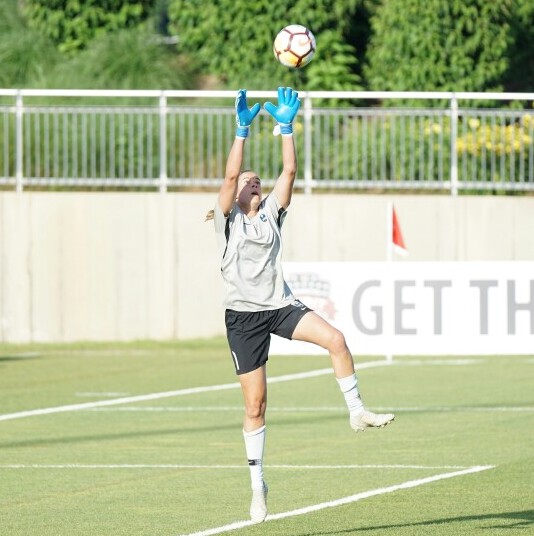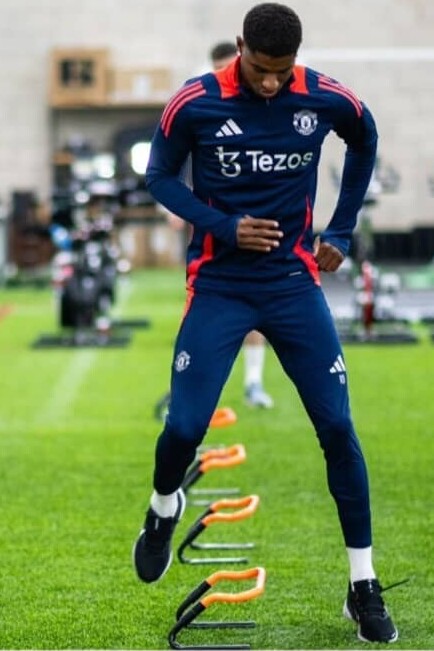Plyometric exercises, often referred to as “jump training,” are a powerful tool for athletes looking to enhance their explosive power, speed, and agility.
For soccer players, plyometrics can be a game-changer, providing a significant boost to their overall athletic performance.
These exercises train the body to utilize maximum force in minimum time, improving key aspects of the game such as acceleration, direction change, and overall field performance.
This comprehensive guide will delve into the science behind plyometrics, explore specific drills tailored for soccer players, and provide practical tips for incorporating them into your training routine.
Understanding Plyometrics
Plyometrics is based on the principle of the stretch-shortening cycle (SSC).
This physiological phenomenon involves the rapid stretching of a muscle (eccentric contraction) followed by an immediate contraction (concentric contraction).
The transition between these two muscle actions generates explosive power.
Plyometrics is unique in that it aims to enhance the body’s ability to store and utilize elastic energy, which can be harnessed for fast, powerful movements—exactly what soccer players need for sprints, jumps, and directional changes.
Key Benefits of Plyometrics for Soccer Players
a. Enhanced Explosive Power: Plyometric exercises specifically train fast-twitch muscle fibers, crucial for quick, explosive movements.
This translates to better acceleration, sharper turns, and quicker sprints, all essential in soccer when chasing the ball or reacting to an opponent.
b. Improved Agility and Quickness: Plyometrics enhances your ability to change direction rapidly.
With faster neuromuscular responses, soccer players can react to passes, opponents, and the ball’s movement in real-time, improving overall agility.
c. Increased Jumping Ability: A stronger lower body and improved muscle coordination from plyometrics can significantly increase vertical jump ability.
For soccer players, this is key for heading the ball, competing in aerial duels, and positioning oneself for high-impact plays.
d. Reduced Injury Risk: Plyometric training strengthens muscles, tendons, and ligaments, improving joint stability and reducing the likelihood of injuries like ankle sprains or hamstring strains.
With proper training, players can avoid injury during intense bursts of sprinting or sharp changes of direction.
Plyometric Drills for Soccer
Here are some of the most effective plyometric drills that can be incorporated into your soccer training routine to improve your explosive power, speed, agility, and overall performance:
a . Box Jumps
- Execution: Stand in front of a sturdy box or platform of appropriate height. Jump explosively onto the box, landing softly with your knees slightly bent. Step back down and repeat.
- Benefits: Develops explosive power in the legs, improves vertical jump, and enhances acceleration—ideal for jumping for headers and sprinting down the field.
b . Depth Jumps
- Execution: Stand on a raised platform (box or bench). Drop down, allowing your legs to absorb the impact, and immediately jump as high as possible after landing.
- Benefits: Trains the stretch-shortening cycle, improves reactive strength, and boosts acceleration and jumping power, which are vital for quick transitions and heading ability.
c . Lateral Jumps
- Execution: Stand in a balanced position and jump laterally to one side. Land softly and immediately jump back to the starting position. Focus on keeping your knees aligned and your core engaged.
- Benefits: Increases lateral power, which helps players move quickly from side to side. This drill is excellent for defensive positioning and sidestepping tackles.
d . Hurdle Hops
- Execution: Set up a series of low hurdles or cones. Jump over each hurdle, alternating legs with each repetition. Maintain good posture and land softly on each hop.
- Benefits: Improves coordination, balance, and leg strength, enhancing agility, acceleration, and quickness when moving through tight spaces or evading tackles.
e . Single-Leg Hops
- Execution: Hop on one leg for a set distance or number of reps, then switch legs. Make sure to land softly and explode off the ground with each hop.
- Benefits: Strengthens each leg individually, which is key for one-legged movements often required in soccer, such as when changing direction or when kicking with precision.
f . Plyometric Push-Ups
- Execution: Perform a standard push-up, but as you push off the ground, explosively elevate your hands, creating a brief “clap” in the air. Land softly and immediately perform the next push-up.
- Benefits: Improves upper body power and explosive strength, which helps in both acceleration and shooting power on the field.
g . Plyometric Lunges
- Execution: Step forward into a lunge position, then explosively jump to switch legs in mid-air, landing back into a lunge position with the opposite leg forward.
- Benefits: Enhances lower body power, coordination, and balance. This drill is vital for accelerating off the mark, as well as for power in tackles and explosive runs.
h . Plyometric Squats
- Execution: Perform a standard squat, but as you reach the bottom position, explode upward into a jump, reaching for a target overhead. Land softly and drop right back into a squat position.
- Benefits: Develops explosive leg power and strengthens the core and lower body, directly improving acceleration, vertical jumping ability, and general leg strength.
Incorporating Plyometric Drills into Your Training Routine
To maximize the benefits of plyometric drills and minimize the risk of injury, it’s essential to follow these key training guidelines:
a . Proper Warm-Up
Always begin with a dynamic warm-up, including light cardio and mobility drills. Plyometrics are high-intensity exercises, and warming up ensures that muscles are prepared for the explosive movements and reduces the risk of injury.
b . Start Gradually
If you’re new to plyometrics, begin with low-intensity exercises like box jumps or hurdle hops. Gradually increase the difficulty by adding more repetitions or height to your jumps as your body adapts. Avoid jumping straight into more advanced exercises.
c . Focus on Quality, Not Quantity
Plyometric training is all about power and precision. Don’t focus on completing a high number of repetitions; instead, emphasize performing each movement with the highest quality possible. Proper technique will yield better results and prevent injuries.
d . Recovery and Rest
Plyometrics place a significant load on muscles, joints, and connective tissues. Make sure to allow adequate recovery between sessions (typically 48-72 hours) to ensure that your body can recover and avoid overtraining. Incorporating stretching, foam rolling, and other recovery techniques will also help.
e . Consult a Professional
If you’re new to plyometrics, consider consulting with a fitness trainer or sports coach to ensure that you’re doing the exercises correctly and in a way that suits your fitness level and goals.
Additional Tips for Maximizing Plyometric Benefits
a. Consistency is Key: To see real improvement in acceleration, agility, and power, plyometric drills need to be incorporated consistently into your training routine. Aim for 1-3 plyometric sessions per week.
b. Progressive Overload: As your body adapts, it’s important to continually challenge yourself by increasing the intensity or adding variations to the drills. This progressive overload ensures continued improvement and development.
c. Track Your Progress: Keep track of your performance by measuring the height of your jumps, the speed of your sprints, and other key metrics.
Tracking your progress will help you stay motivated and identify areas where you need further improvement.
(See our post on soccer wearables)
d. Balance Plyometrics with Other Training: Plyometrics should be part of a well-rounded training program that includes strength training, agility drills, and soccer-specific exercises.
A holistic approach will ensure that you build both power and endurance, vital for soccer performance.
e. Mind Your Form: Always maintain proper form during plyometric exercises.
This means keeping your knees aligned, landing softly, and maintaining an upright posture to prevent strain on your joints.
Take away
Plyometric drills are a powerful way to boost your soccer performance, especially in areas such as acceleration, agility, and jumping ability.
By incorporating these exercises into your training routine, you’ll develop explosive power and the quick reflexes needed to excel on the soccer field.
Remember that consistency, proper technique, and recovery are essential for maximizing the benefits of plyometric training.
Stick to your routine, track your progress, and gradually challenge yourself to improve.
With dedication, plyometrics will help you unlock your full athletic potential and elevate your game to new heights.
I would love to hear from you your thoughts, experiences and or questions about this topic. Please drop them in the comment section below and I promise to get back to you.
Happy and safe training!!!!
Happy soccer season!!!!!!!




2 Responses
What a fantastic article on plyometric drills for soccer players! Your insights into how these exercises can elevate performance are spot on. I’ve seen firsthand how incorporating plyometrics into training can transform an athlete’s game. For instance, I remember working with a youth soccer team where we introduced box jumps and lateral hurdle jumps. The improvement in their agility and jumping ability was remarkable, and it really boosted their confidence on the field.
I like how you highlighted the importance of injury prevention alongside performance enhancement. It’s crucial for young athletes to build strength while minimizing the risk of injuries, especially in such a physically demanding sport.
Have you noticed any specific plyometric drills that work particularly well for different age groups or skill levels?
Thank you so much for your kind words and for sharing your own experiences with youth soccer teams.
It’s always great to hear firsthand accounts of how plyometric training positively impacts players, especially when it comes to improving agility, jumping ability, and confidence on the field.
I completely agree that balancing performance enhancement with injury prevention is absolutely critical, particularly for young athletes still developing their strength and coordination.
To address your question about specific plyometric drills for different age groups or skill levels, here’s what I’ve observed works well:
1. Youth Players (8–12 years old):
At this age, it’s all about focusing on foundational movements and ensuring proper form. Youth players are still developing coordination, so low-impact drills with a focus on body control are ideal.
Drill Suggestion: Lateral Line HopsPlayers hop side-to-side over a line or cone on the ground using both feet, focusing on quick yet controlled movements.Benefits: Improves foot speed, balance, and coordination without overstressing developing joints.Key Consideration: Keep the drills short, fun, and engaging to maintain focus. Avoid excessive repetitions to minimize fatigue and injury risk.
2. Adolescent Players (13–17 years old):
As players mature physically and mentally, you can introduce more advanced drills that challenge their strength and power while still emphasizing injury prevention.
Drill Suggestion: Box JumpsPlayers jump onto a sturdy box or platform and step down carefully. This builds explosive leg power and reinforces landing mechanics to prevent injuries.Progression: Add single-leg box jumps once they master the basic movement.Drill Suggestion: Bounding DrillsPlayers perform exaggerated running strides (bounding) to improve leg power and running efficiency.Benefits: Develops strength, stride length, and coordination.Key Consideration: Incorporate proper warm-ups and cooldowns, as adolescents are at higher risk of growth plate injuries during this stage.
3. Advanced or Elite Players (18+ years old):
For older or highly skilled players, plyometric drills should push the limits of explosive power, speed, and reaction time.
Drill Suggestion: Depth JumpsAthletes step off a box, land softly, and immediately jump as high as possible.Benefits: Builds reactive power and trains the stretch-shortening cycle for quicker, more explosive movements.Drill Suggestion: Lateral Hurdle Jumps with Quick ReboundsPlayers jump side-to-side over hurdles, focusing on minimal ground contact time.Benefits: Boosts agility, lateral movement speed, and ankle stability.Key Consideration: Include strength training alongside plyometrics to build resilience and minimize injury risk from high-intensity drills.
General Tips for All Age Groups:
Always prioritize form over intensity or repetitions. Poor mechanics can lead to injuries, especially in younger players.Introduce progression gradually. Once athletes master the basic movements, add complexity or resistance.Ensure players get adequate recovery between sessions. Plyometrics are demanding on the body, so proper rest is crucial for results and injury prevention.
I hope this helps.
If your youth team or individual athletes have had success with specific drills beyond box jumps and lateral hurdle jumps, I’d love to hear about them.
Sharing knowledge like this helps us all continue to grow and improve as coaches and players.
Thank you again for your thoughtful comment, and I wish your players continued success on and off the field!
Best regards,
Raymond